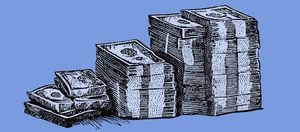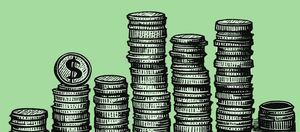Jared is the co-founder and CEO of Fundera, an online marketplace connecting small business owners to the best loans for their business. He writes frequently on small business lending and management.
How to Make Smart Borrowing Decisions (Including Not Borrowing)
9 min. read
Updated October 27, 2023
Most people understand the basics of consumer debt: if you rack up more expenses on your credit card than you can pay back, you’re in big trouble. But, for some reason, when it comes to small business debt, the picture isn’t quite so clear.
Not all businesses are at a point where borrowing money is the best course of action for them. So, what types of businesses should think about taking out a loan? How much debt is okay to incur? Consider all the available options, including which kind of loan is right for your business, and how to ensure that your loan is helping you grow, rather than weighing you down.
To help answer these questions (and more), we went to some of the industry’s best, including Drew Tonsmeire, an Area Director of the Small Business Development Center, Mitchell Weiss, loan expert and author of “Business Happens,” and Gregory Liegey, Vice President at Metrobank and volunteer with the SCORE Association.
Are there options besides borrowing?
Before you decide borrowing is the right path, consider other options.
Being a responsible borrower means looking for every possible way to not take out a loan. A simple option to avoid taking out a loan and make sure your business keeps running smoothly is to work with your vendors. For example, if you own a bakery that caters to corporate clients, chances are you don’t get paid until 30 days after you cater the event, or whatever the corporate client deems as their net terms. Perhaps one of your vendors is the delivery service that transports your baked goods to clients. If you’re paying upfront for delivery, but then waiting 30 days to get paid yourself, that could leave you vulnerable. Instead, consider going into a contract with your delivery service where you promise to provide them with all your business in exchange for them invoicing you for their service, giving you 30 days to pay. “The sooner you begin a relationship, the much more likely it is they will join with you,” Tonsmeire says.
The continued relationship will allow them to more easily trust that you will pay your invoice on time, and gives you the same flexibility you give to your customers. In a sense, this constitutes a very short-term, interest-free loan and it could help your operations significantly.
How much can you actually afford to borrow?
If you have decided you’re ready to borrow money, it’s important to think about how much debt you can afford.
Weiss says, “I love small businesses because they think with two parts of their brain. They think like business people, but the best of them run that enterprise the way they run their household. In running your household, you know you’re not going to spend more than you can afford to pay back. In running a business, don’t do anything differently.”
Responsible borrowing relies on figuring out your debt coverage ratio. Take how much money you earn from your operations each month before paying back any debt, and divide that number by your expected debt payments each month. That ratio should be between 1.25 and 1.50 at the lowest, and ideally it would be higher. The absolute maximum amount you could decide to borrow should be dictated by that ratio.
For example, let’s say you were going to apply for a $50,000 loan over five years. Your total monthly repayment of that loan might be somewhere around $800 a month. After you pay expenses, cash flow from your operations should be about 1.5 times that loan (in this example, that’s close to about $1,200 a month). Can you afford that, and how tight is this going to be? Having a forecast of whether or not you can handle the loan, even in the worst-case downturn scenario, is absolutely crucial.
How much do you ask for (and when)?
When you’re ready to take the plunge, know exactly how much you need and when you are going to need it.
The biggest key to borrowing money is having a reliable business plan for the next two years. If you don’t have one, create one. Figure out what the money you will receive from your loan is needed for, and how much each of those things will cost. Attain estimates from contractors or equipment dealers, and if you’re a startup, think about what expenses you might incur before you open. Consider things such as deposits, franchise fees, hiring, and so on.
When creating your business plan, be sure to consider if there is any lag between when you provide goods or services and when you get paid. Drew Tonsmeire asks, “you can make a sale, but when does the cash change hands? In the same way, you have an expense, but when do you actually have to pay it?” If you can build a budget that forecasts the next two years, and approximate the timing of your sales and expenses, you should be able to calculate a predicted net income to guide your responsible borrowing.
With the financial plan in place, you’ll know exactly how much you’ll need to borrow to cover any future cash shortfalls. Again, the amount you borrow should be less than the maximum amount we described earlier. Finally, you’ll want to apply for a loan several months before the money is actually needed.
The best bet is to have six months of working capital saved in case your business falls on hard times, but it’s also important to remember the context and seasonality of your trade. What are you going to use this cash cushion for? When you calculate what six months of working capital is, do you base that on a monthly average? Is it based on the past six months?
To determine what a responsible borrower would need in the event of an emergency, the past is your best reference. Says Weiss, “If your business has been established for some time, look back to the last recessionary cycle. How far off sales were you? How long to recover? How much did you lose? If you’re a new business, use a proxy. Look at what happened to small businesses in your industry during the last two economic downturns […] What expenses would you cut? How many months of losses would you expect? How would you fund that?”
Weiss also notes that you could even be declined for a pre-existing line of credit if your business starts going south quickly, as you will certainly be asked for updated financial statements. He adds, “the only way to stay ahead of that is with good financial management, to anticipate where the business is headed and start funding yourself through borrowing in advance of [a crisis].” So, be sure you’re keeping a finger on your business’ financial pulse.
Which type of lender is your best match?
After deciding how much you need to borrow and when you need to do it, it’s time to explore your options beyond traditional banking.
Everyone knows the big banks, such as Chase and Citibank, offer small business loans. Sadly, though, many of the larger banks have restricted their lending since the Great Recession, which in turn has caused a rise in alternative lenders. Alternative lenders are institutions other than banks and credit unions that offer financing such as loans, lines of credit and cash advances. Kabbage is a good example of an alternative lender. If you are wary of the traditional bank route, you should have a look at some of the alternative lenders out there. However, it’s important for you to know the difference between the two.
“Typically, alternative financing is more expensive because there’s more risk,” Tonsmeire says, but Liegey adds that alternative lenders tend to be “a little more lenient on lending terms.”
Often, banks can take weeks to review financial statements, business plans and tax histories, and generally require solid credit scores, business collateral and a serious company track record. On the other hand, alternative lenders may use more creative means to determine your creditworthiness, like checking out your customer reviews (on sites like Yelp), social media activity, or even looking directly at your business’s accounting software. As a result, alternative lenders can now approve loans in under a week, making them a great option for businesses that either cannot or do not want to get a loan from a bank.
Which loans should your business consider?
Your business must study the terms of each type loan to decide which is the best fit.
Three main things affect your loan: total borrowed, interest rate and terms, and the total time you’re borrowing. Changing any of those three affects your payment.
To be a responsible borrower, Tonsmeire recommends breaking out short-term expenditures from long-term expenditures, and advises that business owners “try to match the kind of money to the kind of asset [they are] trying to buy.” He defines a long-term asset as something that will last longer than a year. For example, if you were opening a bakery, an oven would be a long-term asset because you’ll use it for years, while flour and sugar would be short-term assets because you’d use them up as soon as you begin to sell inventory.
He says, “If it’s a long-term asset, you might need a financing instrument longer than a year […] At the same time, for short-term assets like inventory, you expect them to sell and be converted to cash, so you typically want to finance that for less than a year.”
Considering these timelines, you could separate your lending into multiple loans so you can get different terms for each expenditure, says Tonsmeire. “Maybe you look into an equipment lease or find one lender who can finance your equipment purchases, and use another source for inventory and accounts receivable,” he advises.
Finally, to truly be a responsible borrower, Weiss recommends scrutinizing the default provisions of the contract: “What happens if you fail to make a payment? What kind of cure period do you have to right a wrong? Folks are so excited to get money that they often don’t look at that provision section of the contract.” Weiss also emphasizes how important it is to compare rates from many different companies to find the best one, because as with anything, shopping around could help you save dramatically.










